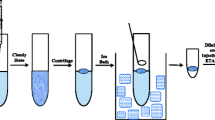Abstract
Dispersive liquid−liquid microextraction solidified floating organic drop (SFOD−DLLME) technique was used for sample treatment and extraction of hexavalent chromium from spiked and real samples of workplace ambient air and urine of chromium electroplating workers. Validation of the SFOD−DLLME technique with three solvents, namely, 1-undecanol, 2-dodecanol and n-hexadecane, showed that pH 4, stirring rates of 600 rpm for 1-undecanol and 2-dodecanol and 800 rpm for n-hexadecane, extraction times of 10 min for 1-undecanol and 2-dodecanol and 15 min for n-hexadecane were the conditions allowing to reach the highest extraction efficiency. The maximum acquired enrichment factor was 211 and LODs were in the range of 0.015–0.05 µg/L, and the calibration curves were linear in the range of 0.5–30 µg/L. The results showed that SFOD−DLLME coupled with atomic absorption spectroscopy is a precise and sensitive technique for the determination of hexavalent chromium for biological monitoring of occupational/environmental samples.





Similar content being viewed by others
REFERENCES
Gallios, G.P. and Vaclavikova, M., Environ. Chem. Lett., 2008, vol. 6, p. 235.
Environmental Protection Agency, Toxicological review of trivalent chromium (CAS no. 16065-83-1), in Support of Summery Information on the Integrated Risk System (IRIS), Washington, DC: US Environmental Protection Agency, 1998.
Priego-Copote, F. and Luque de Castro, M.D., J. Chromatogr. A, 2006, vol. 1113, p. 244.
Agents Classified by the IARC Monographs, vol. 1–120, 2012. http://monographs.iarc.fr/ENG/Classification/ClassificationsAlphaOrder.pdf. Accessed December 20, 2017.
Nriagu, J.O. and Nieboer, E., Chromium in the Natural and Human Environments, New York: Wiley, 1988.
Ahmadi, S.H., Haji Shabani, A.M., Dadfarnia, S., and Taei, M., Turk. J. Chem., 2007, vol. 31, p, 191.
Saygi, K.O., Tuzen, M., Soylak, M., and Elci, L., J. Hazard. Mater., 2008, vol. 153, p. 1009.
Alves, V.N. and Coelho, N.M.M., Microchem. J., 2013, vol. 109, p. 16.
Beni, A., Karosi, R., and Posta, J., Microchem. J., 2007, vol. 85, p. 103.
Wen, S., Wu, J., and Zhu, X., J. Mol. Liq., 2013, vol. 180, p. 59.
Ezoddin, M., Shemirani, F., and Khani, R., Desalination, 2010, vol. 262, p. 183.
Matos, G.D., dos Reis, E.B., Costa, A.C.S., and Ferreira, S.L.C., Microchem. J., 2009, vol. 92, p. 135.
Liang, P. and Sang, H., J. Hazard. Mater., 2008, vol. 154, p. 1115.
Mirzaei, M., Behzadi, M., Mahmoud Abadi, N., and Beizaei, A., J. Hazard. Mater., 2011, vol. 186, p. 1739.
Jeannot, M.A. and Cantwell, F.F., Anal. Chem., 1996, vol. 68, p. 2236.
Liu, H. and Dasgupta, P.K., Anal. Chem., 1996, vol. 68, p. 1817.
Rezaee, M., Assadi, Y., Milani Hosseini, M.R., Ag-haee, E., Ahmadi, F., and Berijani, S., J. Chromatogr. A, 2006, vol. 1116, no. 1, p. 1.
Jahromi, E.Z., Bidari, A., Assadi, Y., Milani Hosseini, M.R., and Jamali, M.R., Anal. Chim. Acta, 2007, vol. 585, p. 305.
Hemmatkhah, P., Bidari, A., Jafarvand, S., Hosseini, M.R.M., and Assadi, Y., Microchim. Acta, 2009, vol. 166, p. 69.
Attari, S.G., Bahrami, A., Shahna, F.G., and Heidari, M., J. Anal. Chem., 2015, vol. 70, p. 1192.
Khalili Zanjani, M.R., Yamini, Y., Shariati, S., and Jonsson, J.A., Anal. Chim. Acta, 2007, vol. 585, p. 286.
Mansour, F.R. and Danielson, N.D., Talanta, 2017, vol. 170, p. 22.
Mandrah, K., Satyanarayana, G.N.V., and Roy, S.K., J. Chromatogr. A, 2017, vol. 1528, p. 10.
Xu, L., Miao, X., Li, H., Liang, J., and Yang, Z., Microchem. J., 2019, vol. 150, p. 104091.
Lu, N., He, X., Wang, T., Liu, S., and Hou, X., Microchem. J., 2018, vol. 137, p. 449.
Viñas, P., Campillo, N., and Andruch, V., TrAC, Trends Anal. Chem., 2015, vol. 68, p. 48.
Guo, X., He, M., Chen, B., and Hu, B., Talanta, 2012, vol. 94, p. 70.
Dadfarnia, S., Salmanzadeh, A.M., and Haji Shabani, A.M., Anal. Chim. Acta, 2008, vol. 623, p. 163.
Dadfarnia, S., Haji Shabani, A.M., and Kamranzadeh, E., Talanta, 2009, vol. 79, p. 1061.
Bidabadi, M.S., Dadfarnia, S., and Haji Shabani, A.M., J. Hazard. Mater., 2009, vol. 166, p. 291.
Rohani-Moghadam, M., Dadfarnia, S., and Haji-Shabani, A.M., J. Hazard. Mater., 2011, vol. 186, p. 169.
Funding
Support of this research by the vice chancellor of research and technology of Guilan University of Medical Sciences (grant no. 93121903) is gratefully acknowledged.
Author information
Authors and Affiliations
Corresponding author
Ethics declarations
The authors declare that they have no conflict of interest.
Rights and permissions
About this article
Cite this article
Pourbakhshi, Y., Heidari, M., Yahaei, E. et al. Dispersive Liquid–Liquid Microextraction Followed by Solidified Floating Organic Drop for Hexavalent Chromium Determination: a Method for Occupational and Environmental Exposure Monitoring for Heavy Metals. J Anal Chem 76, 714–720 (2021). https://doi.org/10.1134/S1061934821060083
Received:
Revised:
Accepted:
Published:
Issue Date:
DOI: https://doi.org/10.1134/S1061934821060083




